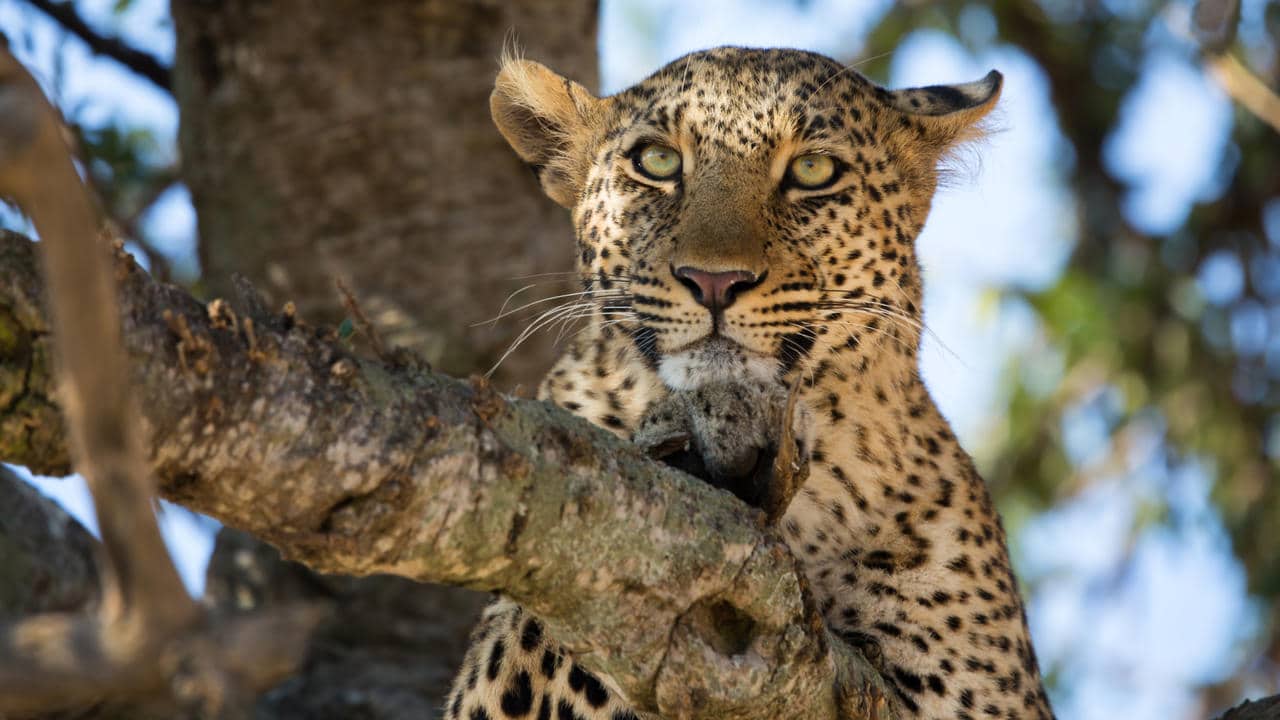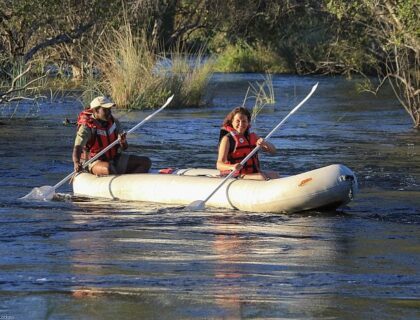It’s the classic safari pub quiz question: leopard or cheetah? Both are spotted. Both are sleek. And both will have you fumbling for your binoculars in embarrassment if you get it wrong.
There are several differences between these two superb predators. Both in appearance and in character. And that also means that you are likely to encounter them in different wildlife terrains. And, as you read on, you’ll see that these differences between leopard vs cheetah are all inter-related.
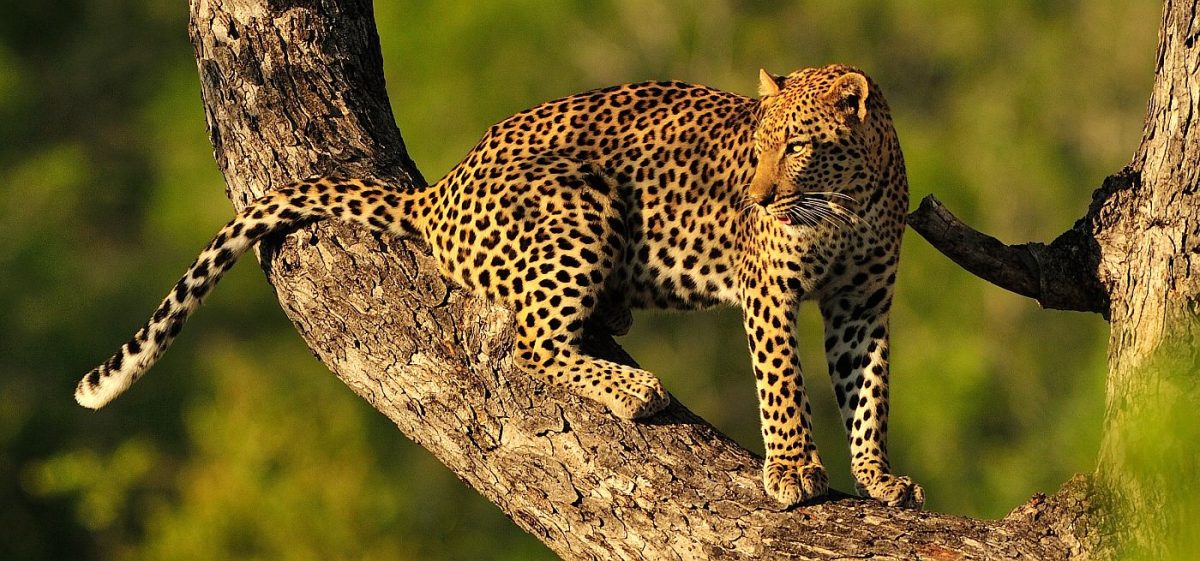
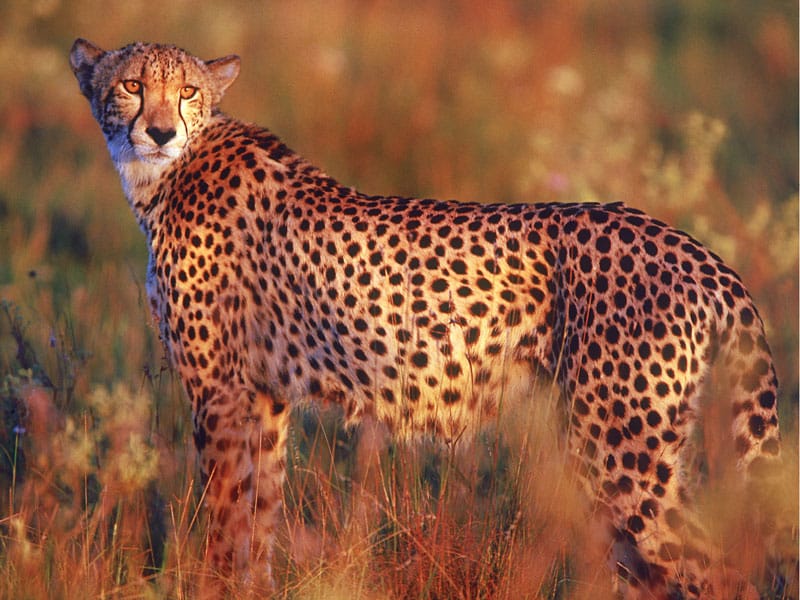
Their different body shape influences their style of attack. Their style of attack influences the sort of terrain that they want to inhabit. The terrain that will give them the best chance of making a successful kill and keeping the successful kill.
Their size and family structure influences their position in the predator pecking order. And this position also influences their scarcity and where they like to hang out.
So, we’ll look at the following differences between cheetah and leopard:
- Appearance
- Family structure
- Style of Hunting their Prey
- Preferred Terrain
- Position in the Predator Pecking Order
- Scarcity
- Shyness
- Collared
Spots, Speed & Safari Myths: Cheetah versus Leopard Explained
| FEATURE | LEOPARD | CHEETAH |
| Build (Appearance) | Muscular | Lean and Aerodynamic |
| Spots | Rosette-shapped | Solid Black Spots |
| Facial Markings | No Tear Lines | Distinctive Black ‘Tears’ |
| Social Structure | Solitary | Males may Form a Coalition |
| Style of Hunting | Stalking using trees/think bush as camouflage | Relying on Speed |
| Preferred Terrain | Wooden terrain | Open Plains |
| Climbing Ability | Excellent | Rarely Climbs |
| Hunting Time | Nocturnal | Diurnal |
| Speed | Up to 55-60 km/hour | Up to 110 km/hour |
| Scarcity | Plentiful but elusive | Low numbers but increasing |
| Shyness | Very shy | Can become semi-habituated (but children are seen as prey) |
| Numbers in Africa | 125,000 (estimated) | 7,000 (estimated) |
Difference in Appearance
Spotting the Difference in Appearance – How to Tell a Cheetah from a Leopard on Safari
(Excuse the pun)
At first glance leopard and cheetah seem remarkably similar. But once you know the tell-tale signs, they’re easy to tell apart. Like confusing Brad Pitt with Idris Elba… both impossibly good-looking, but hardly identical. The main differences you will spot between leopards and cheetahs are their spots, eyes, and their build.
- Cheetahs: Think polka-dot party. Their spots are solid black circles or ovals dotted consistently across their tan coats. Whereas leopards are all about the rosette — the high-fashion logo of the feline world.
- Leopard spots group up to form clusters resembling open circles or ‘rosettes’ with a deep brown spot in the middle
- A cheetah has black tear grooves between the eyes and mouth – think permanent eyeliner gone wrong. Whereas as leopard has more open facial features, with no black distinctive lines.
- The leopard (built for strength) is far stockier and solid, which allow it to move its prey to safer ground, typically up a tree, or to a wooded koppie out of sight.
- The cheetah is built for speed and is more slender with long legs for explosive speed. The cheetah is built like a running machine
So, next time you’re staring through binoculars on safari, you’ll know exactly who’s who.
Leopard Statistics:
Population Size: Unknown
Age: 10 – 20 years
Top Speed: 58 km/h
Weight: 40 – 90 kg
Height: 57 – 70 cm
Length: 90 – 190 cm
Habitat: Desert And Semi-Desert Regions, Arid Regions, Savanna Grasslands, Mountainous Environments, Rainforests, And Occasionally Urban Areas
Appearance: These large carnivores are powerfully built with stocky bodies, relatively short legs, and a broad head. They’re surprisingly heavy for their compact size. Their bodies are designed for stealth, climbing, and power.
There are nine subspecies and are distinguished by the unique characteristics of their coats, which range from tawny or light yellow in warm, dry habitats to reddish orange in dense forests.
Their coat is covered in dark, irregular spots called rosettes. These spots are circular in east African leopards, but square in southern African leopards. The tail is ringed, and the animal has distinct black markings on its face, chest, and feet.
Leopards have longer, more angular faces and a powerful set of jaws destined for crunching through bones and sinew.

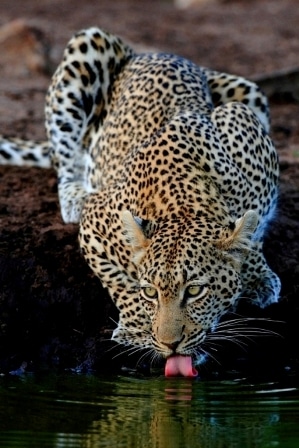
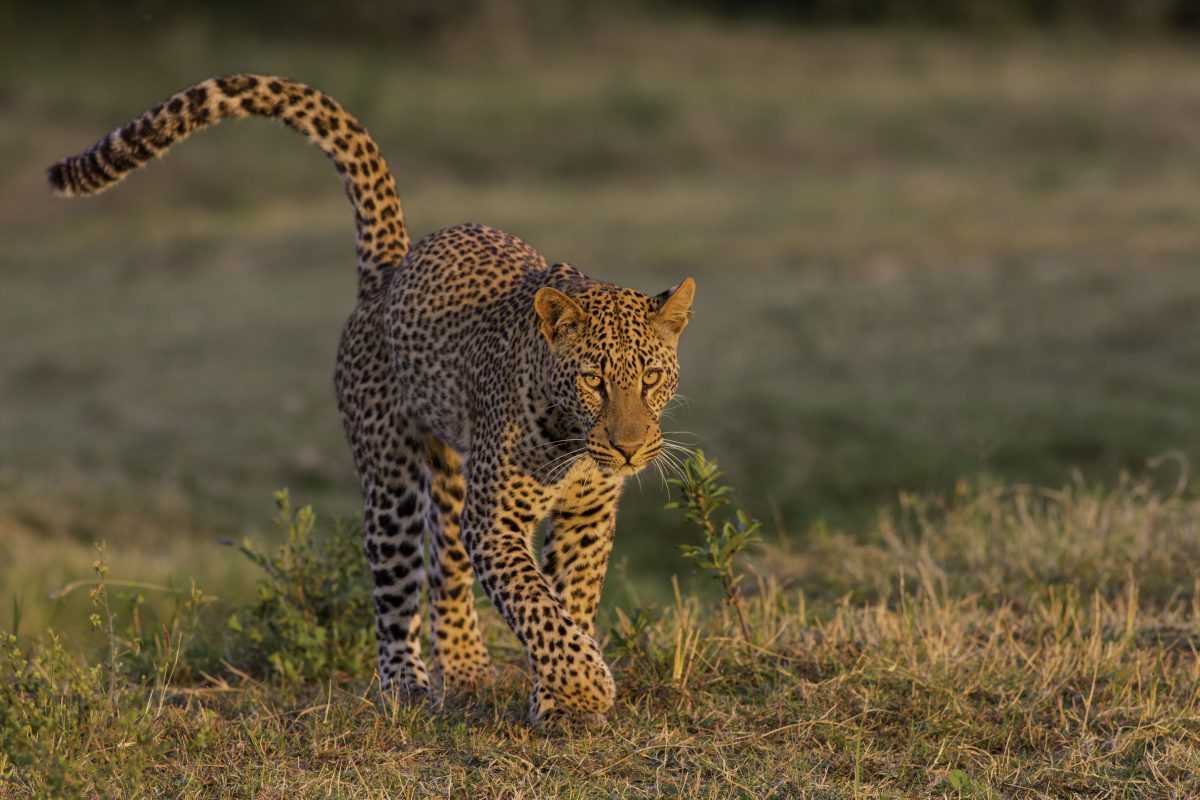
Cheetah Statistics:
Population Size: ± 7,000
Age: 10 – 20 years
Top Speed: 112 km/h
Weight: 21 – 72 kg
Height: 70 – 90 cm
Length: 112 – 150 cm
Habitat: Wide range of habitats—from dry forests and thick scrubs through grasslands and Sahara Deserts. In order to hide from predators, these animals prefer an environment with lush vegetation such as tall grass or bushes.
Appearance: The cheetah is a large cat identified by black marks (so-called “tear marks”), running down from the inner eye along the nose to the outside of the mouth.
Cheetahs are all about aerodynamics. Tall at the shoulder but lean and streamlined, they’re built for one thing: speed.
The cheetah is an extremely agile animal, having powerful hind legs and a very flexible, muscular spine. The body is long and slender, covered with coarse yellowish fur with small black markings. The tail is spotted with ringed markings, having a black tip on its end. In addition, the tail is quite long, helping the cheetah to keep balance and change direction.
Other Subtle Clues:
- Eye colour: Cheetahs often have amber or brown eyes, while leopards can sport piercing green or blue hues.
- Sounds: Only leopards can deliver a proper feline roar. Cheetahs communicate in chirps and purrs instead.
- Length & Height: Oddly enough, cheetahs are taller at the shoulders, but leopards are longer overall.
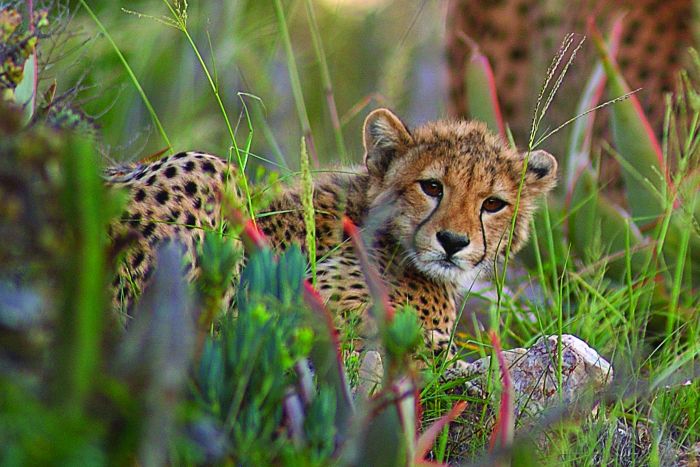


Social Lives: Solitary Leopards and Cheetah Coalitions
Cheetah vs Leopard – Solitary Leopards or Cheetah Coalitions
Unlike lions, who are very sociable and work as a team, both leopards and cheetah are generally solitary. Leopards are generally asocial animals, living alone and avoiding other leopards. Moreover, when leopards accidentally encounter each other, they can engage in a fight.
In contrast cheetahs live in three main social groups: females with their cubs, male “coalitions”, and solitary males. Females lead a nomadic life searching for prey in large home ranges. Males are more sedentary and instead establish much smaller territories in areas with plentiful prey and access to females.
When younger, they often form coalitions with other young males to assist each other with catching their prey. Once matured, they prefer to operate alone and not have to compete with others for the attention of the females.
Style of Hunting Their Prey
Cheetah vs Leopard – Style of Hunting
Unlike other large African predators such as lions, leopards or hyenas, cheetahs are most active during the day; this way they avoid competition for food with these animals.
Leopards are nocturnal and hunt at night, usually on the ground or from vantage points in trees. They are the masters of stealth. They need an environment which offers plenty of hiding spots, such as thick bush, forests, and rocky outcrops. Trees aren’t just picturesque scenery for leopards; they’re vital. These cats not only use them for cover but also as vantage points, nap spots, and even storage places for their prey.
They depend on their acute senses of hearing and vision for hunting. A leopard will creep up incredibly silently and the final burst of speed will be over a shorter distance. Ideally, they will stalk their prey and try to approach to within 5 m (16 ft) of the target, and, finally, pounce on it and kill it by suffocation.
In contrast, cheetahs rely on their amazing top speed to catch their prey. Cheetahs will silently creep as close as possible, identify a vulnerable animal (either one that it young, or wandered away from the pack, or heavily pregnant). Then they’ll use their incredible acceleration to run it down. They can get up to 100 km/hour in just 3 seconds. That’s faster than most super cars!
But as you can imagine, it needs a certain type of terrain for this to work. Ideally a flat open savanna plain. Preferably with long grass to hide its approach.
Then it will be able to reach its full speed and not have to worry about tripping over a rock or navigating trees which will slow it down.
Interested in booking a Safari or Holiday?
Chat to one of our experienced consultants that’s here to help and guide you. We use our expertise to narrow down the choices and present feasible ideas, so you can relax and ENJOY the planning process! Contact us!Differences in Hunting Time and Vision: Cheetah versus Leopard
If you’ve ever been on safari, you’ll have noticed that cheetahs and leopards run on different schedules. Leopards are the masters of the nocturnal hustle, while cheetahs prefer their action served sunny-side up.
Leopards have evolved for twilight and nocturnal adventures. Their eyes are decked out with a high concentration of light-sensitive cells, making them the feline equivalent of night-vision goggles. With large eyes and wide pupils, they soak up every speck of moonlight – giving them a serious advantage when it’s dark.
Cheetahs, on the other hand, are built for the daylight dash. Their vision is packed with cone cells, designed to pick up detail and motion in bright light. This means they excel at hunting in day time, spotting prey from a distance and tearing across the savanna at top speed. (They also sidestep the lion and leopard competition after dark by avoiding late-night prowling altogether.)
In short: leopards rule the night, cheetahs own the day.
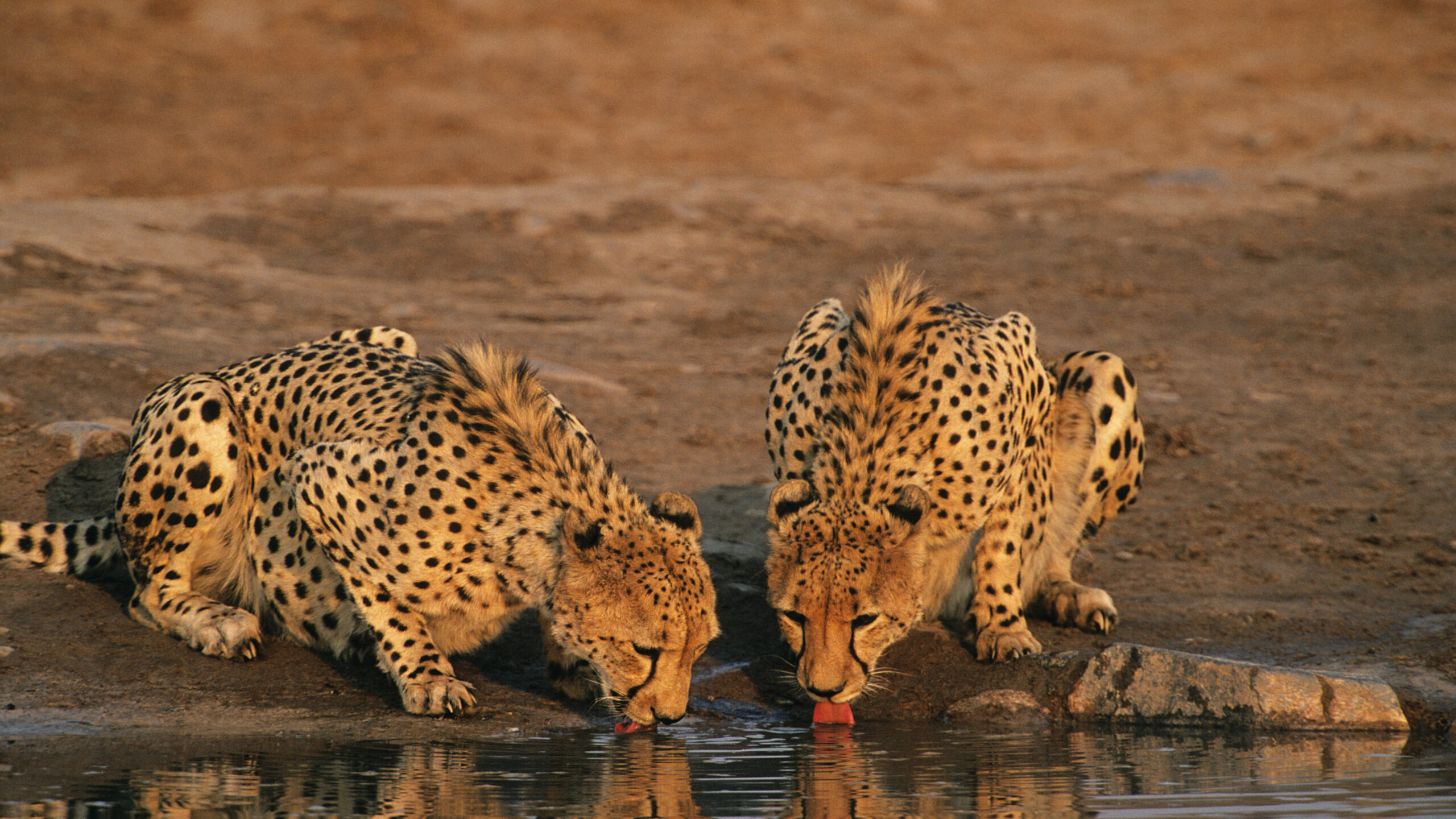
Differences in Hunting Time and Vision: Cheetah versus Leopard
Both cats aren’t picky eaters, but they each have gourmet quirks of their own.
Typical Prey for Cheetahs:
Cheetahs feed upon smaller antelope such as puku or impala. When there is a shortage of food, hares or young wildebeest might end up as appetizers if the opportunity arises.
Because cheetahs rely on explosive chases, they gravitate toward prey they can catch and subdue quickly.
Typical Prey for Leopards:
Leopards, on the other hand, are the ultimate opportunists of the bush. They hunt almost anything that crosses their path— ranging from rodents and monkeys to ground birds and even large antelopes that can easily outweigh them.
The diet of leopards includes a wide variety of animals such as jackals, antelopes, monkeys, duiker, impala, wildebeest, birds, rodents, rock dassies, hares, snakes, sheep, goats and even insects.
But its greater size and strength allows it to kill slightly larger wildlife. Even larger animals such as eland or wildebeest can occasionally be killed by leopard, (though that’s unusual).
A leopard’s unique party trick? Hoisting heavy meals up into trees, where they can dine in peace, out of reach from other hungry competitors. When times are tough, leopards don’t shy away from scavenging or switching things up: fish, insects, and even the occasional beetle are fair game.
Plus, leopards attain all their required moisture from their food, so they can survive without drinking water for extended periods of time.
Safari tip: Leopards are the only big cats that regularly stash food in trees to avoid thieves like hyenas. That’s why looking up into trees often rewards you with a sighting.
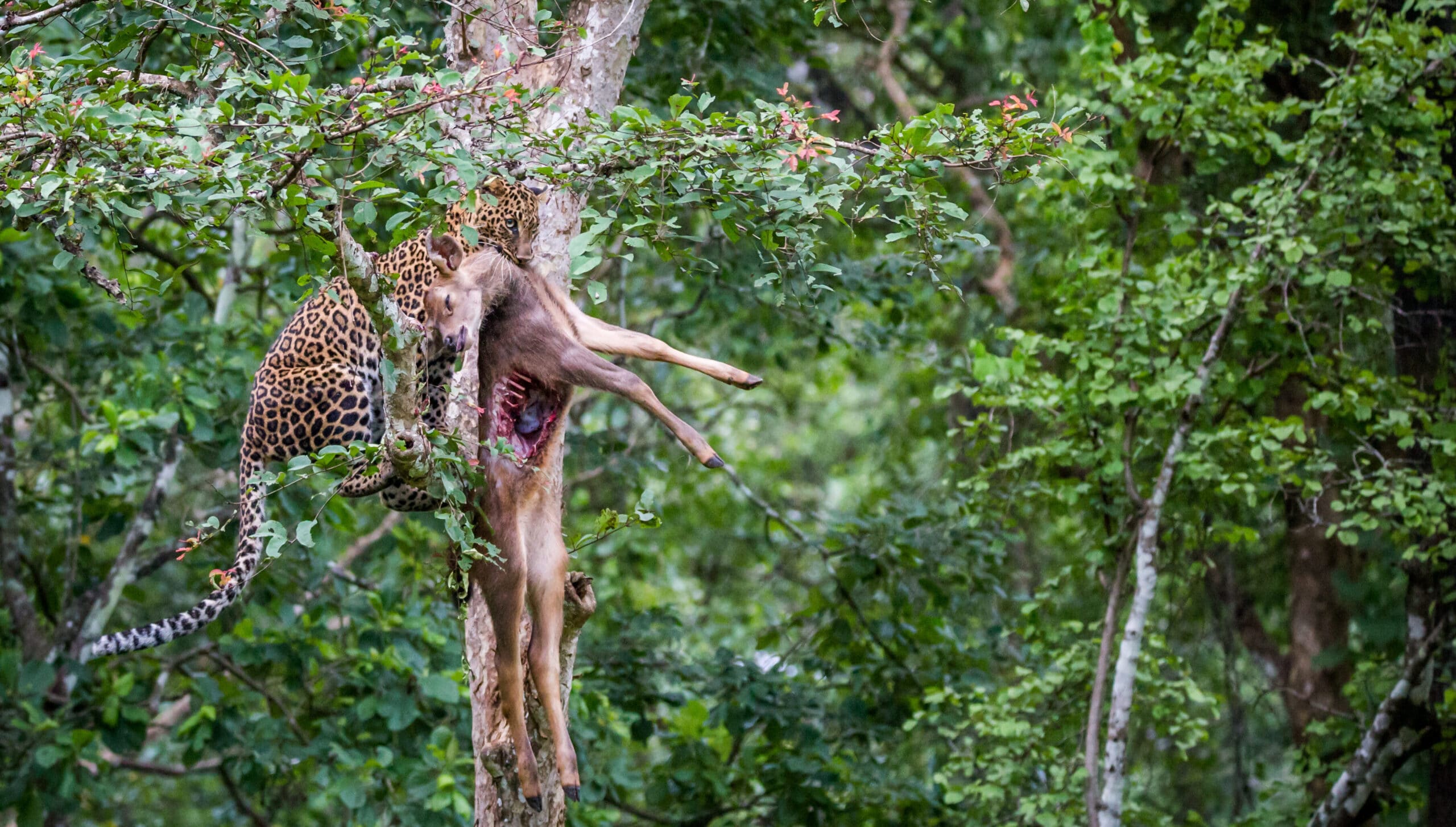
Preferred Terrain and Distribution
Leopard vs Cheetah – Preferred Habitats
So naturally this leads to one of the biggest differences between leopard and cheetah. Where you will find them…
As a (very) broad rule, if the terrain is ideal for cheetah, then it is not great for leopard and vice versa. So, if a game reserve is boasting about its great leopard sightings, don’t expect to see too many cheetah there as well.
Leopards like rocky outcrops and wooded terrain which they can use as cover as they approach. Cheetahs are happiest on the open savanna plains. Dense forests or heavily-wooded areas cramp their style, quite literally. If there’s enough room to run, the cheetah is happy.
Naturally, the larger game reserves such as the Kruger National Park, the Serengeti, the Masai Mara will have a range of terrain and so both leopard and cheetah can be found there, though usually, but not always in distinct parts of the park.
But if you are keen to see these animals, decide which one you most want to see? (See Scarcity later)
Best Places to See Cheetah in Southern Africa
- Kwandwe Game Reserve, Eastern Cape
- Samara Karoo Lodge, Eastern Cape
- Kgalagadi Transfrontier Park, Northern Cape
- Shamwari Long Lee Manor, Eastern Cape
- Phinda Game Reserve, Northern KwaZulu Natal
- Central Kalahari (Botswana/South Africa)
- Kalahari Desert of Namibia
- Etosha National Park (Namibia).
- Kafue National Park (Zambia)
Best Places to See Leopard in Southern Africa
- Kruger National Park and its private game reserves – Sabi Sand and Timbavati
- Shamwari Long Lee Manor, Eastern Cape
- Hluhluwe-iMfolozi Game Reserve (KwaZulu Natal)
- South Luangwa National Park, Zambia
- Lower Zambezi National Park, Zambia
- Okonjima Game Reserve, Namibia – leopard tracking experience
- Hwange National Park (Zimbabwe)

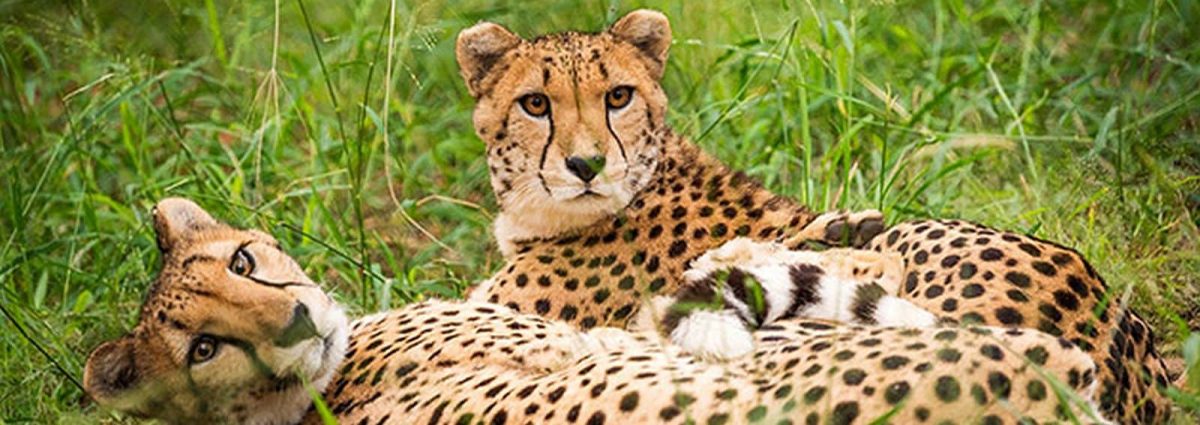
Leopard and Cheetah – Territorial
Leopard is also far more territorial than cheetah. They will stick to a particular part of a game reserve. Whereas cheetah will easily roam over a vast terrain.
Position in the Predator Pecking Order
Leopard vs Cheetah – Pecking Order
This is important to also note; Lions are at the top of the pecking order in terms of successful kills. Followed by Leopard and then Cheetah. So, if the carrying capacity of a game reserve is relatively low, due to poor soils, lack of rain etc., and there are lions in abundance, then cheetah will find it hard to co-exist.
Whereas leopards who act alone in stealth attacks, have a very different modus operandi to lions. So often they can co-exist relatively easily with lions. But if there are plentiful lion, then leopard will also find it harder going unless the terrain works particularly well for them.
Scarcity
Cheetah vs Leopard – Numbers in the wild
From humid rainforests and arid deserts to chilly mountain slopes and maddy swamps, leopards have carved out homes across vast swathes of Africa — surpassing the cheetah’s more limited range.
So naturally it will not come as a surprise to you when I say that cheetah is the most vulnerable and scarce of these cats.
Estimated Populations in Africa and in South Africa
| Animal | Numbers in Africa | In South Africa |
| Lion | ± 23,000 | ± 13,000 |
| Leopard | ± 125,000 | ± 2,185 to 23,400 |
| Cheetah | ± 7,000 | ± 1,826 |
Indeed Cheetah is so scarce that many private game reserves in South Africa participate in a gene-pool sharing scheme. Whenever new cheetah cubs are born in their reserve, after they are reared from their mother’s milk, they are captured and transported to a different reserve. This ensures that the gene pool stays strong and there are no genetic inbreeding problems. This has worked incredibly successfully.
Due to their tendency to roam over vast distances, this has led to cheetah impacting local livestock farming far more than a leopard. Especially in Namibia.
In Namibia, in order to ensure than cheetahs are not shot by farmers to protect their livestock, there are several cheetah rehabilitation centres. Cheetahs are captured from farms – where they are in danger of getting shot – and taken to these centres to get them used to hunting wild prey again. (As hunting domesticated animals is much easier and so cheetah can get used to it.) Then later they are translocated back to the real wilderness.
Shyness
Leopard vs Cheetah – shyness
The leopard is a shy and elusive animal. It likes to live in the shadows. That is how it remains a successful hunter. (And perhaps why its numbers remain high.)
But there are a few private reserves, especially in South Africa, which have worked closely with leopard over many decades. So that the leopards in these reserves know that a game vehicle is not a threat to them. Effectively they have become used to the vehicle and so you see them more often.
But this is not the norm!
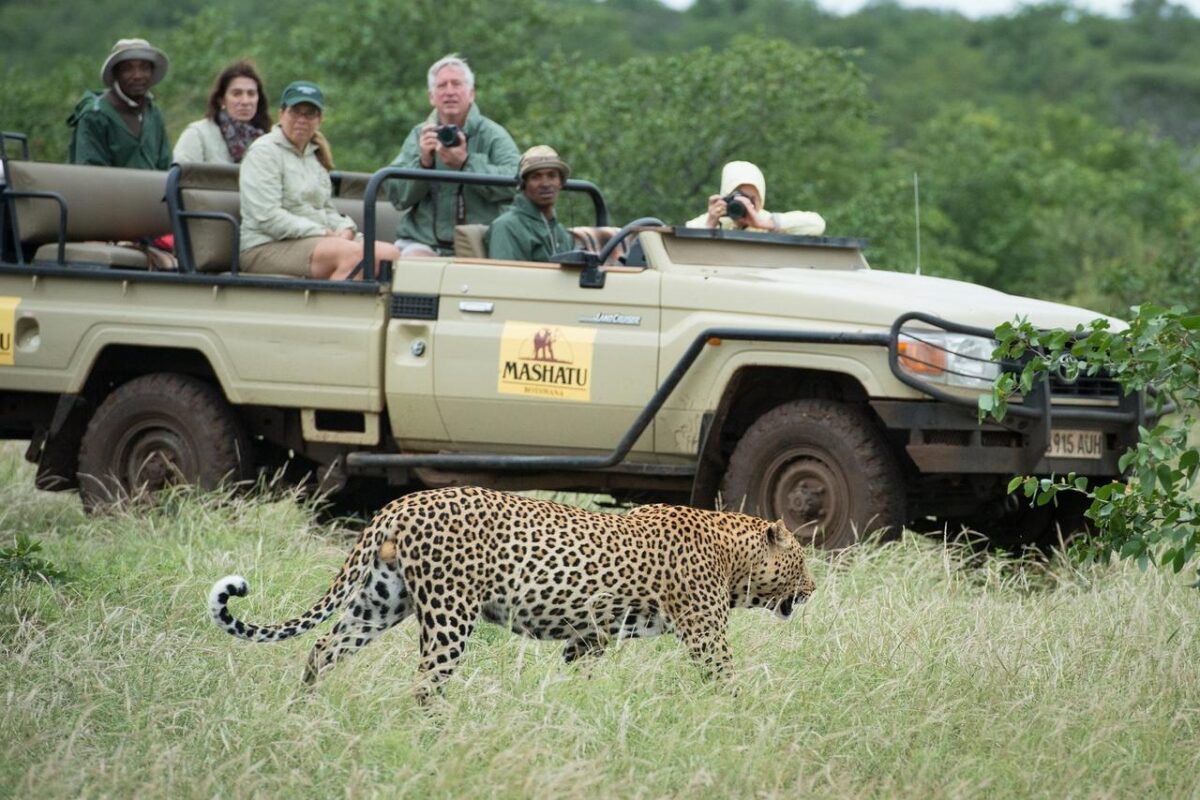
(Note: It also means that many private game reserves can truthfully say that they have the “Big Five” but your chances of seeing all of them will be extremely low. As it is the leopard in the Big Five which may elude you.)
Aside on the Cape Mountain Leopard
I have lived in the Cedarberg for over 30 years. We have between 50 and 100 Cape Mountain Leopard in the Cederberg Mountains. But I know of only THREE people who have ever seen one! You see their spore. You see their droppings. A sheep farmer will lose an occasional sheep to a hungry leopard. But I have never seen one. And probably never will.
In contrast a cheetah is far less wary of a human. Of all the big cats, these are the only ones which have been known to become semi-domesticated if trained in the past. Though such practises are very much frowned upon nowadays. This means that at some cheetah rehabilitation centres, you are highly likely to see cheetah even though they may be in large enclosures.
Collared
Cheetah vs Leopard – collared
And the final difference, partially due to their scarcity and the consequent need for translocation, is that you may find that the cheetah population is collared in many game reserves. This does not mean that they are tame in any way. It just allows the researchers to find them. And it means that your chances of tracking them in their vast open ranges is enhanced. But never guaranteed.
Leopards are virtually never collared! are virtually never collared!
Top Tips for Seeing Cheetah and Leopards in Africa
Top Tips for Seeing Cheetah in Africa
So, if I have done my job correctly, the following tips should be obvious:
- Head to game reserves with lots of wide-open savanna or Kalahari plains
- If a reserve boasts about its leopard sightings, cheetahs are less likely to be seen.
- If it is HIGH on your priority list in South Africa, you may want to head to a reserve which has a cheetah rehabilitation programme as usually they know how to find their cheetah, and often they are collared so that the researchers can find them relatively easily.
- As they are so scarce, allow yourselves at least 3 nights in any one reserve in cheetah-friendly terrain. Preferably four.
Best places to see Cheetah in South Africa
- Eastern Cape Game Reserves especially Kwandwe, Samara and Shamwari – see below
- Kgalagadi Transfrontier Park, Northern Cape
- Phinda Game Reserve, Northern KwaZulu Natal
Where to see Cheetah – Some favourite lodges in these areas (note: no guarantees)
- Phinda Mountain Lodge, Phinda, Northern KwaZulu Natal
- Amakhosi Safari Lodge, Northern KwaZulu Natal
- Shamwari Long Lee Manor, Eastern Cape
- Kwandwe Game Reserve, Eastern Cape
- Samara Karoo Lodge, Eastern Cape
Best places to see Cheetah in Southern Africa (Namibia, Botswana, Zambia, Zimbabwe)
- Central Kalahari Game Reserve, Botswana
- Etosha National Park, Namibia.
- Kafue National Park, Zambia
- Okonjima Game Reserve, Namibia
Where to see Cheetah – Some favourite lodges in these areas (no guarantees!)
- Onguma Tented camp, Etosha
- Busanga Bush camp, Kafue, Zambia
- Okonjima, Central Highlands, Namibia
- Epako Lodge, Central Highlands, Namibia
Best places to see Cheetah in East Africa
- Serengeti National Park. Tanzania
- Masai Mara National Park, Kenya
- Amboseli National Park, Kenya
- Ruaha National Park, southern Tanzania
But the lodges are too numerous to mention!
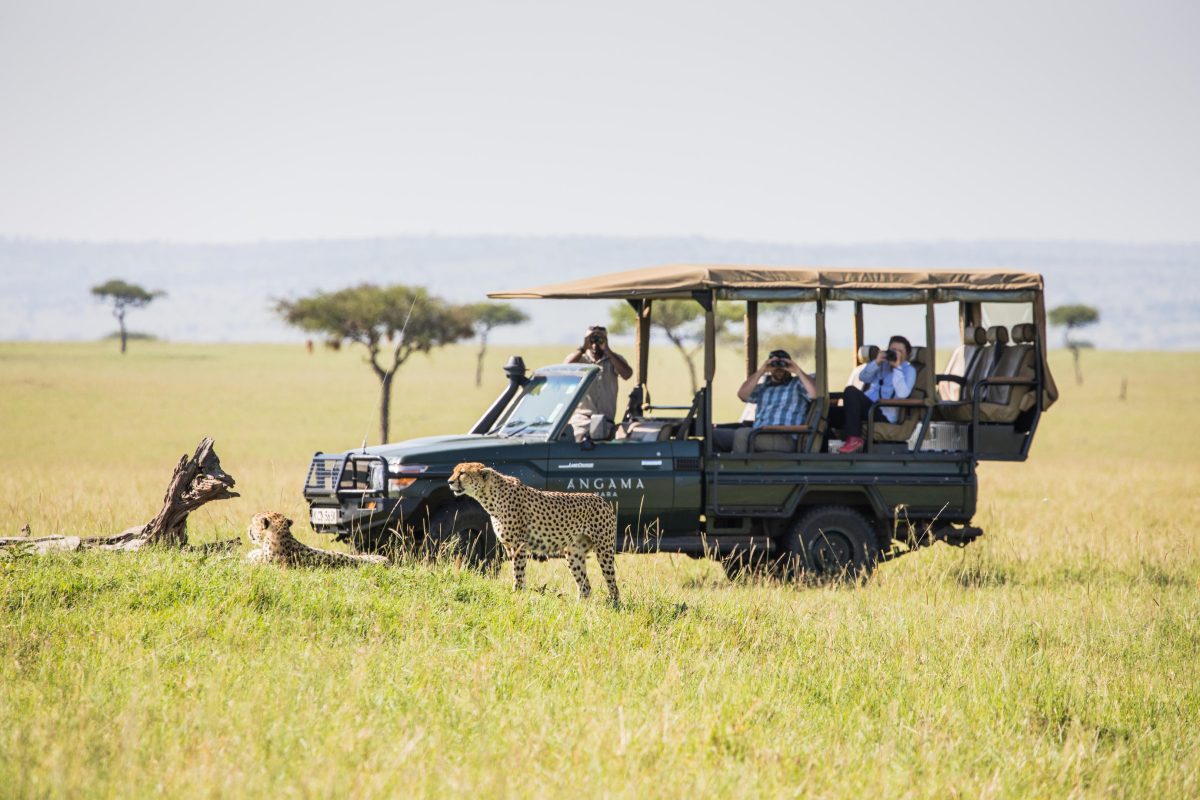
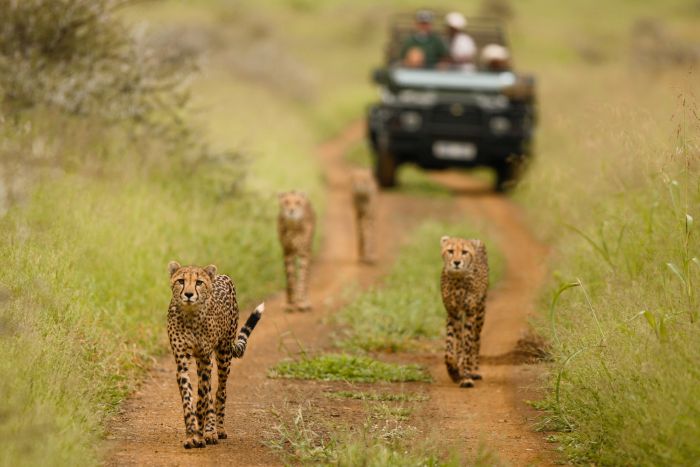
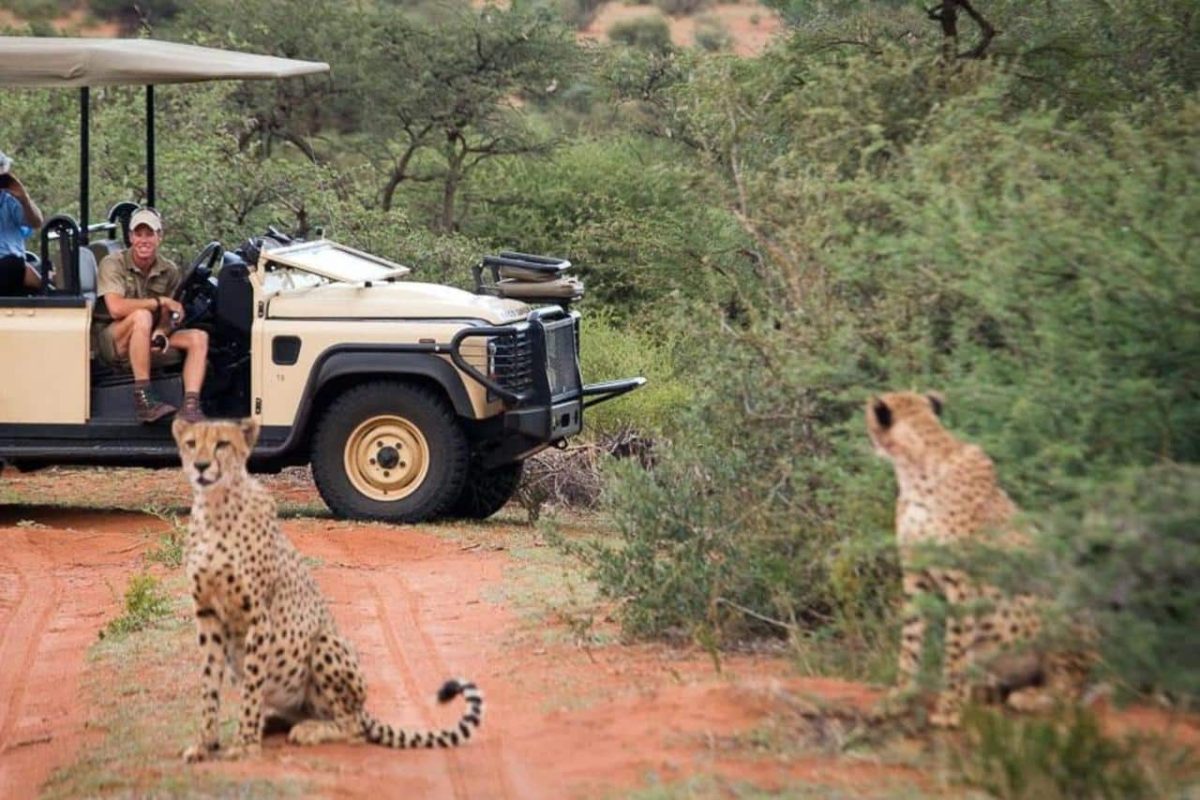
Top Tips for Seeing Leopard in Africa
And in reverse, the best chances of seeing leopard in Africa are the following:
- Head to game reserves with lots of bushy terrain, wooded glades koppies, riverine vegetation and plentiful trees
- If a reserve boasts about its cheetah sightings, then it’s not usually the right terrain for leopards.
- If a reserve talks about plentiful leopard sightings, or leopards being used to the vehicle, then that’s a good sign. If the copy just mentions that they HAVE leopard, that doesn’t mean you will see it.
- As with cheetah, allow yourselves at least 3 nights in any one game reserve. Preferably four, to maximize your chances.
Best places to see Leopard in South Africa:
Where to see Leopards – Some favourite lodges in these areas (no guarantees)
Any game lodge in the above reserves will offer a good chance of seeing leopard so these are just some of our favourites.
- Dulini River Lodge, Sabi Sands
- Londolozi, Sabi Sands
- Mala Mala, Sabi Sands
- Kings Camp, Timbavati
- Simbavati River Lodge, Timbavati
Best places to see leopard in Southern Africa (Namibia, Botswana, Zambia, Zimbabwe)
- Moremi Game Reserve, Okavango Delta, Botswana
- Mana Pools National Park, Zimbabwe
- South Luangwa National Park, Zambia
- Lower Zambezi National Park, Zambia
- Okonjima Game Reserve, Namibia – leopard tracking experience
Where to see Leopard – Some favourite lodges in these areas (no guarantees)
All game lodges IN these game reserves will offer a good chance of seeing leopard, so these are just some of our favourites
- Camp Xakanaxa, Moremi
- Nyamatusi camp, Mana Pools
- Puku Ridge Camp, South Luangwa
- Chiawa Camp, Lower Zambezi
Best places to see Leopard in East Africa
- Serengeti National Park, Tanzania
- Ngorongoro National Park, Northern Tanzania
- Ruaha National Park, Southern Tanzania
- Maasai Mara National Park, Kenya
- Samburu National Park, Kenya
Again, too many lodges to mention by name.

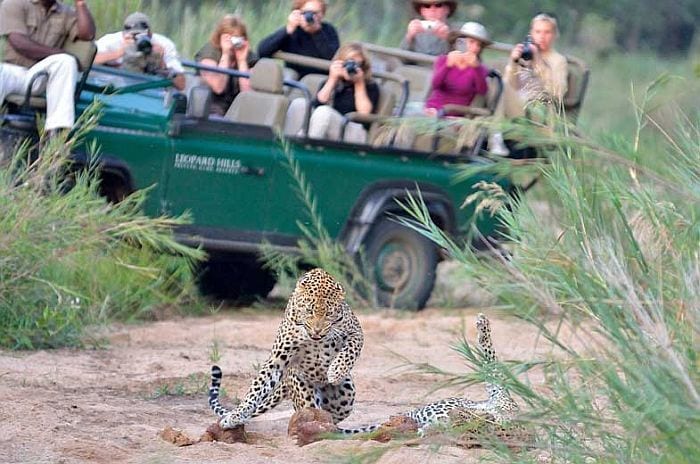
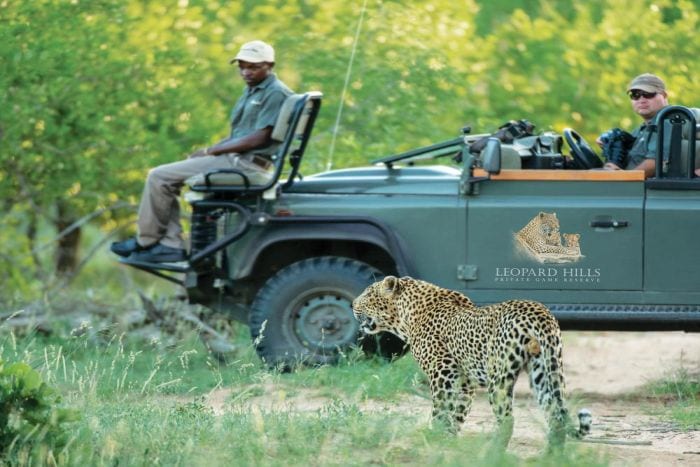
Frequently Asked Questions
What are the visual differences between a Leopard and a Cheetah?
Leopards have rosette-shaped spots; cheetahs have solid black spots. Cheetahs have distinctive black “tear marks” under their eyes.
How fast can a Cheetah run?
They can get up to a top speed of over 110km/hour with 0 to 100km/hour in around 3 seconds.
Are leopards stronger than Cheetah?
Yes, they are more muscular and can carry a substantial prey animal up into a tree to store it away from other predators. Cheetah are built for speed with long limbs and an aero-dynamic shape. So when a leopard encounters a cheetah in the wild, it’s almost always the cheetah that backs down.
Are Cheetah part of the Big Five?
No, they’re not. Historically the Big Five comprises the animals most dangerous to hunt on foot (so lion, elephant, rhino, buffalo and yes, leopard.)
Can Leopard and Cheetah be seen in the same game reserve?
Though generally they prefer different terrain., if a game reserve has both type of terrain eg open plains and also denser wooded, then it is perfectly possible to see both. Especially at different times of day, and where the carrying capacity of wildlife means that there is enough food to go round.
Which is more likely to be seen on safari? Leopard or Cheetah?
Depends on where you go. Cheetah are more likely to be seen in much of East Africa (flat open plains) and in parts of Southern Africa. However, leopard are much more common in the Kruger area, the private game reserves of Sabi Sands and Timbavati, and in South Luangwa and Lower Zambezi of Zambia as these are more wooded areas.
Do a cheetah’s claw retract?
Cheetahs have claws that aren’t fully retractable. Think of them like built-in cleats – giving these speedy cats extra grip as they sprint after their prey.
On the flip side, leopards sport fully retractable claws, sharp and tucked away until they’re needed for climbing trees or pinning down dinner. Because leopards keep their claws hidden most of the time, their tracks usually show neat paw prints without any sign of claw marks.
So, if you’re ever looking at tracks in the dirt, here’s a handy tip: cheetah tracks often display visible claw impressions, while leopard tracks typically lack them.
Are Cheetah endangered?
Yes, they are vulnerable with only approx. 7,000 left in the wild.
Leopard and Cheetah: Now why not spot the Difference on Safari?
Reading about leopards and cheetahs is fun. Seeing them on safari? Unforgettable.
Safari Planning in 3 Easy Steps:
- Chat with us about what you’d love to see and do. Big cats? Big bodied wines? Wide open savanna plains?
- We do the legwork curating a personalised safari, balancing bucket-list animals with the right lodges.
- You relax, enjoy the anticipation, and start packing your binoculars.
Ready to put your new leopard vs cheetah knowledge to the test?
Let’s turn safari theory into safari reality.
Let’s Design Your Safari TogetherLeopard vs. Cheetah: Do YOU know the difference? – was written by Cedarberg Africa
We’re African safari specialists with 30 years’ experience (and yes, we can tell a leopard from a cheetah at 100 paces). We focus on personalised, upmarket safaris that suit you – not the other way round.

